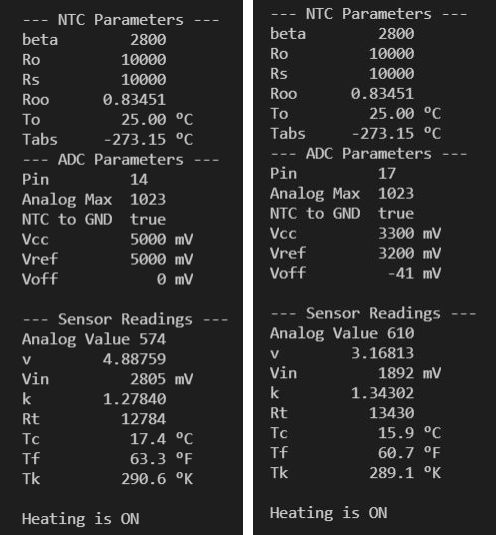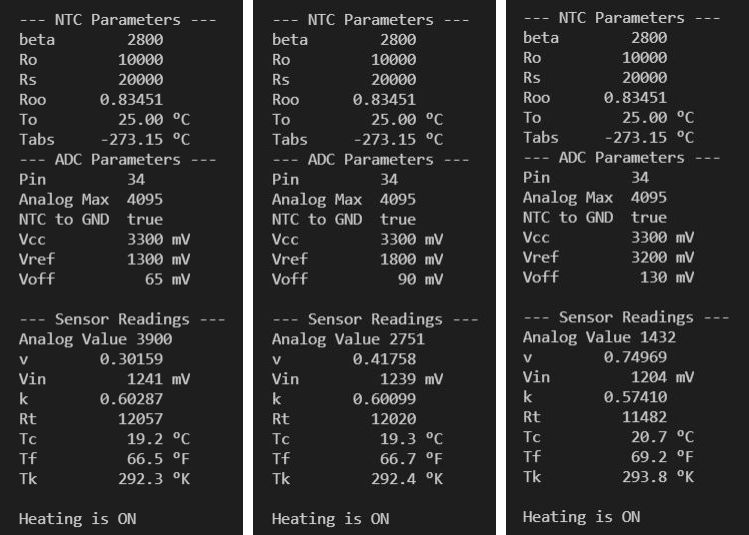Shows how to realize a thermostat with a NTC resistor
Maybe you also have some of these strange components in your tinkering box, which you removed from a defective battery pack or an old PC power supply. These are NTC resistors, i.e. resistors with a negative temperature coefficient. Their resistance therefore decreases with increasing temperature. They are suitable for temperature measurement or, as the title of this project says, for building a thermostat.
If we connect an NTC resistor in series with another resistor whose value we know, we can measure the voltage at this voltage divider and calculate the unknown resistance value of the NTC from it. We can set up the voltage divider in two different ways, namely connect the NTC to ground or to Vcc.
---+-- Vcc ---+--- Vcc
| |
.-. .-.
| | Rs |\| NTC
'-' '-'
| |
+---> analog input +---> analog input
| |
.-. .-.
|/| NTC | | Rs
'-' '-'
| |
---+--- GND ---+--- GND
If we assume that the ADC (analog to digital converter) of our microcontroller delivers the value Aval between 0 and Amax (e.g. 0..1023), for input voltages from 0V to Vcc , the resistance of the NTC for the two cases is calculated as follows:
Rt = Rs * Aval / (Amax - Aval) Rt = Rs * (Amax - Aval) / Aval
or with or with
k = (Amax -Aval) / Aval k = (Amax -Aval) / Aval
= Amax/Aval - 1 = Amax/Aval - 1
we get we get
Rt = Rs * 1/k (NTC to GND) Rt = Rs * k (NTC to Vcc)
Now we know the resistance of the NTC. But how do we calculate the temperature from this? The formula of Steinhart-Hart helps us here ( see NTC ) :
R(T) = Ro * exp(BETA * (1/T - 1/To) Steinhart–Hart equation
===================================
To Nominal temperature, normally 25°C 🚩 for calculations use degrees Kelvin 🚩
Ro Resistance of the NTC resistor at nominal temperature R(To)
Roo = Ro * exp(-BETA / To) Resistance for T --> oo
Rt = Roo * exp(BETA / T) Resistance at temperature T
T = BETA / ln(Rt / Roo) Temperature as a function of measured resistance
In the Steinhart-Hart equation BETA denotes the characteristic parameter of the NTC. It can be taken from the data sheet of the NTC or calculated from 2 resistance measurements at different temperatures:
T2 * T1
BETA = ------- * ln(R1 / R2) R1, R2 measured resitance values at
T2 - T1 two different temperatures T1, T2
The ADC of the Arduino Uno maps the full input range 0..5V to the range 0..1023
The ADC of the ESP8266 has an input range of 0..1V which is mapped to 0..1023. But the Wemos D1 has an internal voltage divider 220k/100k with midpoint connected to the ADC and the 220k-endpoint connected to pin A0. Therefore the input voltage to convert at A0 must not exceed 3.2V to get the full range.
The ADC of the ESP32 has selectable attenuations for different reference voltages. It maps the input voltage to the range of 0..4095. Unfortunately the ADC also has a certain offset voltage which we have to consider ( see ADC ESP32 ) :
Attenuation ADC_0db ADC_2_5db ADC_6db ADC_11db (default)
Vref 1100mv 1300mv 1800mv 3200mv
Voff 65mv 65mv 90mv 130mv
We can express this relationship with a linear equation:
Vin = Aval * v + Voff with v = (Vref - Voff) / Amax
If we look at the series connection of Rs and Rt we see that Vin = Vcc * Rt / (Rs + Rt) if the NTC is connected to GND, or Vin = Vcc * Rs / (Rs + Rt) if Rt is connected to Vcc. So for the two cases we get for the resistance value of the NTC to GND: Rt = Rs * k or NTC to Vcc: Rt = Rs / k with k = Vin / (Vcc - Vin)
So with this knowledge, we can connect the network Rs/Rt to any voltage Vcc as long as we keep the input voltage Vin smaller than the reference voltage Vref of the ADC.
From the considerations made, we see that quite a lot of parameters have to be taken into account. Therefore we pack these into two structures, one for the NTC and one for the ADC. Further, we take into account that the attenuation only applies to the ESP32.
using ParamsNTC = struct paramsNtc {
uint16_t Rs;
uint16_t Ro;
uint16_t beta; };
#ifdef ESP32
using ParamsADC = struct parmsAdc{
uint8_t pin;
bool ntcToGround;
uint16_t Amax;
adc_attenuation_t att;
double Vcc;
double Vref;
double Voff; };
#else
using ParamsADC = struct paramsAdc {
uint8_t pin;
bool ntcToGround;
uint16_t Amax;
double Vcc;
double Vref;
double Voff; };
#endif
}
Now we are able to design two classes, one for the NTC sensor, the other for the thermostat. The constructor of the NTCsensor class takes two references as arguments, one to the NTC, the other to the ADC parameters. The member variables are initialized, the pin mode of the analog input pin is set and the constant Roo is calculated.
class NTCsensor
{
public:
NTCsensor(ParamsNTC &ntc, ParamsADC &adc) : _ntc(ntc), _adc(adc)
{
pinMode(_adc.pin, INPUT);
#ifdef ESP32
analogSetAttenuation(_adc.att);
#endif
// calculate the resistance of the NTC for T --> oo
_Roo = _ntc.Ro * exp(-(double)_ntc.beta / (_To - _Tabs));
}
Of course, we would like to be able to query the temperature in °C, °F and °K and also output the parameters of the NTC. The corresponding methods are provided for this purpose.
A thermostat is really nothing more than a switch that triggers appropriate actions
at certain temperatures. That is why we pass to the constructor of the NTCthermostat
class only a reference to a sensor object and the references to 3 callback functions.
onDataReady() is called every loop interval, the other two callbacks only when the
corresponding lower or upper temperature limits are reached.
using Callback = void (&)();
class NTCthermostat
{
public:
NTCthermostat(NTCsensor &ntcSensor, Callback onLowTemp,
Callback onHighTemp, Callback onDataReady) :
_ntcSensor(ntcSensor), _onHighTemp(onHighTemp),
_onDataReady(onDataReady) {}
The temperature is measured periodically in the loop() method. The measurement interval and the two temperature limits are set with corresponding methods. All other details can be seen in the code. The program compiles for Arduino UNO R3, Wemos D1 R2 and DoIt ESP32 DevKit V1 by simply switching the PlatformIO Project Environment.
The program simply outputs the parameter settings and the measured values periodically. The displayed outputs show that the measured values differ considerably from board to board.
Output for UNO R3 and Wemos D1
Output for ESP32 ADC_2_5db / ADC_6_db / ADC_11db


